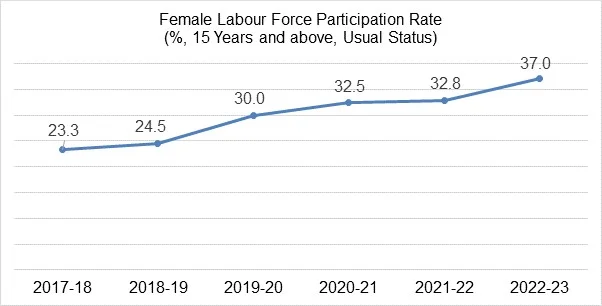Nari Shakti Surges Ahead!
The Periodic Labour Force Survey Report 2022-23, released by the Ministry of Statistics and Programme Implementation on October 9, 2023, indicates a significant improvement in the Female Labour Force Participation Rate in India. According to the ‘usual status’ concept of measuring labor force participation, the Female Labor Force Participation Rate has increased by 4.2 percentage points to reach 37.0% in 2023. This improvement is a positive sign for female employment and workforce participation in the country.

Government’s Initiatives
The notable increase in the female labor force participation rate reflects the government’s commitment to empowering women through various policy initiatives that promote their long-term socio-economic and political development. These initiatives encompass different stages of a woman’s life, such as:
- Girls’ Education: The government has launched extensive programs to promote girls’ education, ensuring that they have access to quality schooling.
- Skill Development: Various skill development programs have been implemented to equip women with the necessary skills for better employment opportunities.
- Entrepreneurship Facilitation: Initiatives to support women in becoming entrepreneurs and business leaders, fostering economic independence.
- Workplace Safety: Policies and legislations have been enacted to enhance safety in the workplace, addressing issues of workplace harassment and creating a more conducive environment for women.
These efforts collectively contribute to the government’s goal of promoting “women-led development” and fostering women’s active participation in India’s workforce.
About Labour Force Participation Rate
The labor force participation rate (LFPR) is the percentage of the working-age population that is either employed or actively seeking employment. It is calculated by dividing the labor force by the working-age population.
The working-age population is typically defined as people aged 15 to 64. However, this definition can vary from country to country.
The LFPR is an important economic indicator because it provides a measure of the size of the workforce and the level of economic activity. A high LFPR indicates that a large proportion of the working-age population is either employed or actively seeking employment. This is generally considered to be a good thing, as it indicates that the economy is growing and that there are opportunities for people to find work.
- Weekly Current Affairs 2025 PDF For Bank, SSC, UPSC Exams
- Unsung Heroes of India: 10 Unknown Freedom Fighters You Should Know
- 26 December Current Affairs 2023 in English
- Daily Current Affairs 2025, Check Today’s Current Affairs
- April Month Current Affairs 2024, Download PDF
- June Month Current Affairs 2024, Download PDF

Hello, I’m Aditi, the creative mind behind the words at Oliveboard. As a content writer specializing in state-level exams, my mission is to unravel the complexities of exam information, ensuring aspiring candidates find clarity and confidence. Having walked the path of an aspirant myself, I bring a unique perspective to my work, crafting accessible content on Exam Notifications, Admit Cards, and Results.
At Oliveboard, I play a crucial role in empowering candidates throughout their exam journey. My dedication lies in making the seemingly daunting process not only understandable but also rewarding. Join me as I break down barriers in exam preparation, providing timely insights and valuable resources. Let’s navigate the path to success together, one well-informed step at a time.






